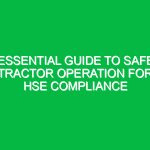Welcome to Today’s Toolbox Talk
Hello team! Thank you for gathering here today for our Toolbox Talk. Our focus is on an often-overlooked topic in the realm of health, safety, and the Environment (HSE): Playing the Lottery and Workplace Injuries. While the phrase “playing the lottery” usually brings to mind thoughts of chance and luck, we will explore how this metaphor applies to the unpredictable nature of workplace injuries and the Safety Strategies that can help mitigate those risks. Understanding this connection is critical for maintaining a safe work environment and ensuring that we all return home safely at the end of the day.
Understanding the Concept: Playing the Lottery in the Workplace
When we think about Playing the Lottery, we often think of the excitement of winning and the risks of losing. However, in the context of Workplace Safety, this concept can be used to illustrate the unpredictable nature of accidents and injuries. Every day you come to work, you essentially “play the lottery” with your Safety; the outcomes can vary significantly based on your actions and environment.
Let’s take a moment to reflect on how this relates to Workplace Injuries. Just like in a lottery, where the odds can be stacked in your favor or against you, workplace Safety is influenced by various factors, including your awareness, the conditions around you, and the Precautions you take.
The Reality of Workplace Injuries
According to the Occupational Safety and Health Administration (OSHA), millions of workers are injured on the job each year. These injuries can range from minor to severe and can lead to long-term health issues or even fatalities. By understanding the nature of these injuries, we can better prepare ourselves to avoid them.
Common Types of Workplace Injuries
Here are some of the most common workplace injuries that we might encounter:
- Slips, trips, and falls: These accidents can occur due to wet floors, uneven surfaces, or cluttered walkways.
- Overexertion: Lifting heavy objects or repetitive motions can lead to strains and sprains.
- Being struck by objects: Tools, equipment, or materials can fall or be thrown, causing injuries.
- Vehicle-related incidents: These include accidents involving forklifts, trucks, or other vehicles used in the workplace.
- Exposure to harmful substances: Chemicals or hazardous materials can lead to serious health issues if proper Precautions are not taken.
Identifying Risks: The Odds of Injury
Just as with any lottery, understanding the odds can help you make informed choices. By identifying potential Hazards in your workplace, you can understand the “odds” of an injury occurring and take steps to reduce those risks. Here are some key areas to assess:
- Environment: Are there any physical Hazards in your work area? Look for wet floors, uneven surfaces, or clutter that could lead to slips and falls.
- Equipment: Is all equipment functioning correctly? Regular checks can prevent accidents caused by malfunctioning tools.
- Procedures: Are safety protocols being followed? Non-compliance with Safety Measures can increase the likelihood of injuries.
- Training: Are you and your coworkers adequately trained to handle equipment and recognize hazards? Continuous education can significantly lower risks.
Playing the Lottery: A Safety Mindset
How can we change our perspective from merely “playing the lottery” to actively improving our odds of safety? Here are some strategies to help foster a safer workplace culture:
1. Emphasize Safety Training
Regular safety training is crucial in ensuring that all employees are aware of potential hazards and the proper Procedures to mitigate those risks. This includes:
- Conducting regular drills for emergency situations.
- Providing refresher courses on equipment and safety protocols.
- Encouraging open discussions about safety concerns and suggestions for improvement.
2. Foster a Culture of Communication
Open lines of communication can significantly reduce the risk of accidents. Employees should feel comfortable reporting unsafe conditions or behaviors without fear of retribution. Establishing a culture where safety is prioritized can encourage everyone to be vigilant.
3. Utilize Personal Protective Equipment (PPE)
Using appropriate PPE is essential in mitigating risks. Always wear the necessary gear for your specific tasks, whether it be helmets, gloves, goggles, or harnesses. Remember, PPE is your first line of defense against injuries.
4. Regular Safety Audits
Conducting safety audits can help identify potential hazards before they result in injuries. Regular checks can ensure that Safety Measures are up-to-date and effective. These audits should include:
- Inspection of tools and equipment.
- Review of safety protocols and compliance.
- Assessment of workspaces for hazards.
5. Create a Reporting System for Incidents
Establishing a clear reporting system for near-misses and incidents can provide valuable insights into the effectiveness of current safety strategies. Understanding what went wrong can help prevent future occurrences.
Real-Life Examples: Learning from Others
Let’s take a moment to share some real-life examples that highlight the importance of safety strategies in preventing injuries:
Case Study 1: The Forklift Incident
In a warehouse, an employee was injured when a poorly maintained forklift malfunctioned while carrying heavy cargo. The lack of regular Maintenance checks led to an accident that resulted in a long recovery for the employee. Following this incident, the company implemented a rigorous maintenance schedule and provided additional training for all forklift operators. As a result, the number of forklift-related injuries dropped significantly.
Case Study 2: The Slippery Floor
In an office environment, a wet floor caused an employee to slip and sustain an ankle injury. After this incident, the management instituted a policy requiring immediate signage and cleaning of spills. They also provided anti-slip mats in high-traffic areas. This proactive measure greatly reduced slip and fall incidents.
Engaging with the Team: Open Discussion
Now, I would like to open the floor for discussion. Here are a few questions to consider:
- What are some hazards you have encountered in your daily tasks?
- Do you feel comfortable reporting unsafe conditions? Why or why not?
- What additional training or resources do you think could help improve Workplace Safety?
Your insights are invaluable in creating a safer work environment for everyone. Remember, safety is a shared responsibility.
Regulations and Compliance: The Legal Side of Safety
Staying compliant with osha Regulations and company policies is not just about avoiding penalties; it’s about protecting yourself and your coworkers. Compliance ensures that you are following established safety Standards that minimize risks. If you’re unsure about specific regulations or company policies, don’t hesitate to ask your supervisor for clarification.
Conclusion: Safety is a Shared Commitment
In conclusion, we have highlighted the metaphor of Playing the Lottery and its connection to Workplace Injuries. By understanding the risks, implementing effective safety strategies, and fostering open communication, we can improve our odds of a safe work environment. Remember, every day is a new opportunity to prioritize safety and make informed choices.
Thank you all for your attention and your commitment to maintaining a safe workplace. Together, let’s ensure that we all go home safe and healthy at the end of each workday.


